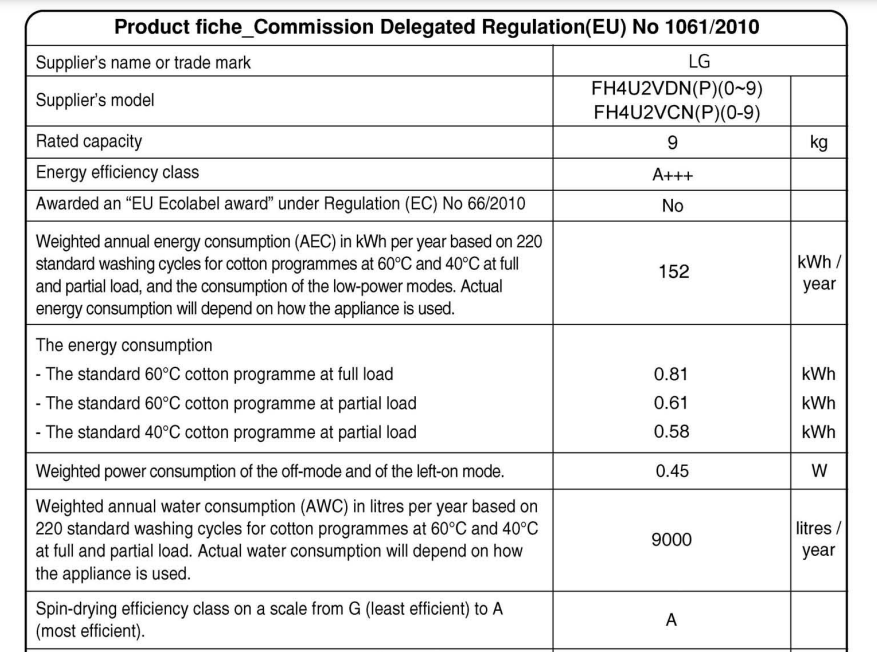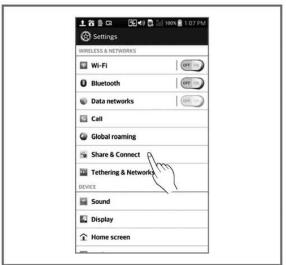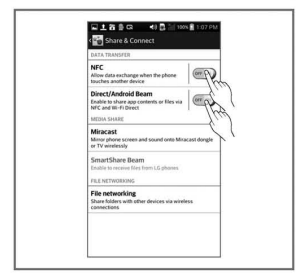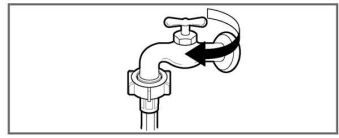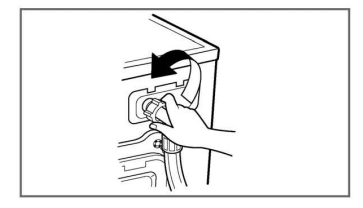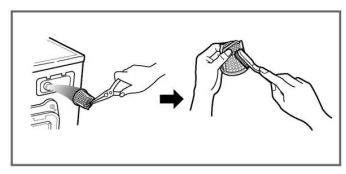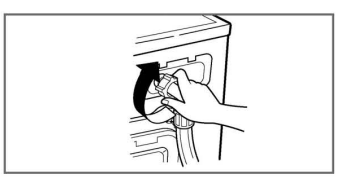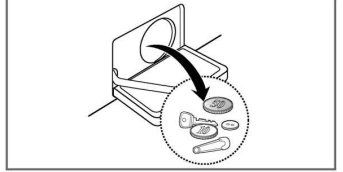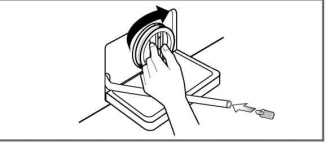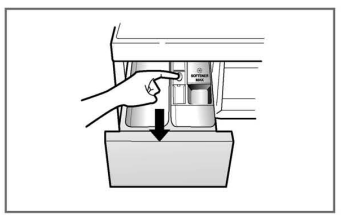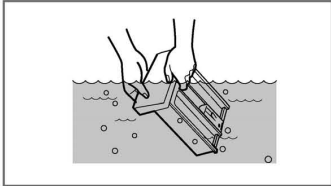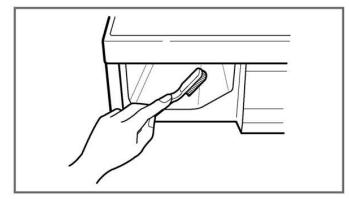Documents: Go to download!
- Owner's manual - (English)
- Product Features
- Specifications
- Installation
- How to use washer
- REGULATION
- ADDING DETERGENT
- Maintenance
- Troubleshooting guide
- Operating data
Table of contents
User Manual Washing Machine
Product Features
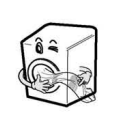 Inverter Direct Drive system
Inverter Direct Drive system
The advanced Brushless DC motor directly drives the drum without belt and pulley.
 6 Motion
6 Motion
Washer is able to perform various drum actions or a combination of different actions depending on the wash program selected.
Combined with a controlled spin speed and the ability of the drum to rotate both left and right. the wash performance of the machine is greatly improved. giving you perfect results every time.
 Turbo Wash
Turbo Wash
Wash cycle in under 1 hour with energy and water saving (based on half of laundry).
 Tag on
Tag on
This is a function that may use Diagnosis, Download, Cycle Washing Coach, One Touch Washing, etc. when you touch the Tag On logo of the washing machine by using your smartphone with NFC.
 More economical with Intelligent Wash system
More economical with Intelligent Wash system
Intelligent Wash System detects the size of load and water temperature, and then determines the optimum water level and washing time to minimize energy and water consumption.
 Child Lock
Child Lock
The Child Lock prevents children from pressing any button to change the settings during operation.
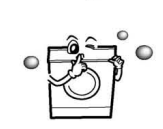 Low noise speed control system
Low noise speed control system
By sensing the amount of load and balance, it evenly distributes load to minimize the spinning noise level.
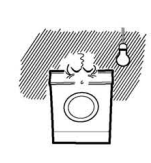 Auto Restart
Auto Restart
See other models: LFXS30726S FH6F9BDS2 LFXS26973S W5J5QN4L DLEX9000V
Auto Restart allows the program to restart all by itself in case of power failure. It does from the stage where it stopped.
 Smart Diagnosis
Smart Diagnosis
Should you experience any technical difficulty with your washing machine, it has the capability of transmitting data by phone to the Customer Information Center. The call center agent records the data transmitted from your machine and uses it to analyze the issue, providing a fast and effective diagnosis.
Specifications
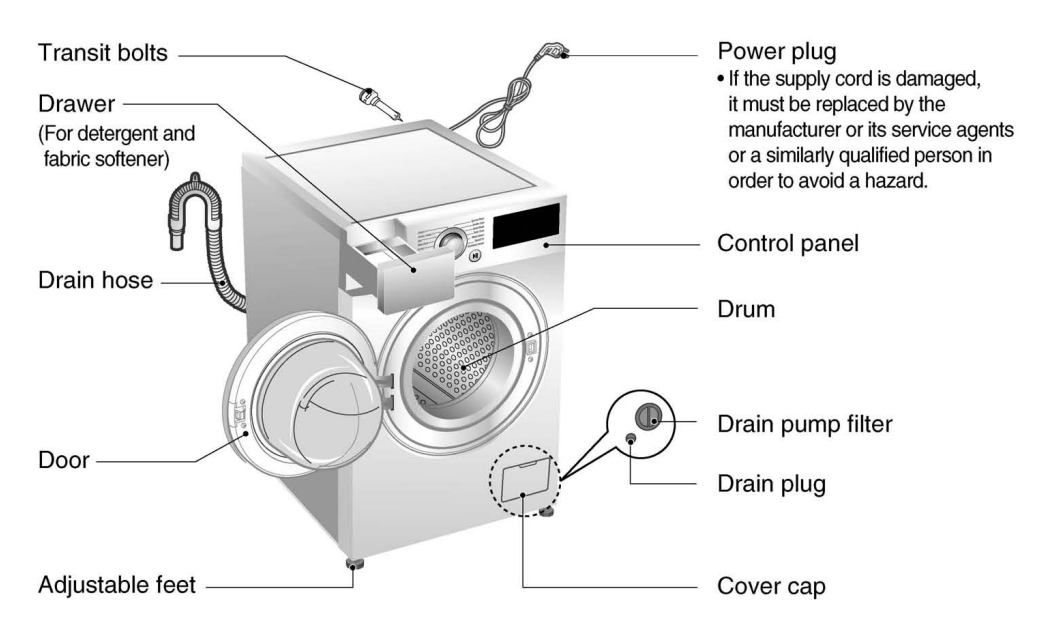
- Name: Front loading washing machine
- Power supply: 220 - 240 V~. 50 Hz m@ Size : 600 mm (W) X 560 mm (D) X 850 mm (H)
- Weight : 63 kg
- Max.Watt : 2100 W, 0.45 W (The off-mode. The left-on mode)
- Wash capacity: 9kg
- Permissible water pressure: 100 - 1000 kPa (1.0 - 10.0 kgf / cm’)
*The appearance and specifications may vary without notice to improve the quality of the unit.

Installation
Removing packing
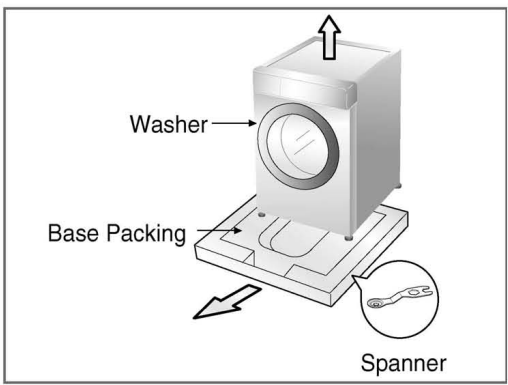
- Remove the cardboard box and styrofoam packing.
- Lift the washing machine and remove the base packing.
- Remove the tape securing the power supply cord and drain hose.
- Remove the inlet hose from the drum.
Note: Keep the spanner provided for future use.
 WARNING
WARNING
- Packaging material (e.g. Films. Styrofoam) can be dangerous for children.
- There is a risk of suffocation! Keep all packaging well away from children.
Removing transitbolts
To prevent internal damage during transport, the 4 special bolts are locked. Before operating the washer. remove the bolts along with the rubber bungs. If they are not removed, it may cause heavy vibration, noise and malfunction.
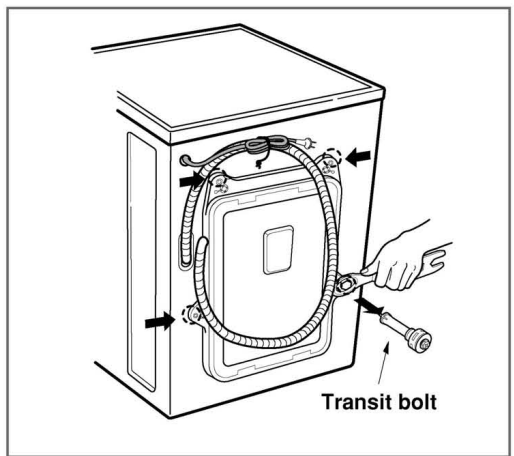
- Unscrew the 4 bolts with the spanner supplied.
- Take out the 4 bolts along with the rubber bungs by slightly twisting the bung.
Note: Keep the transit bolts for future use.
- Close the holes with the caps supplied.
Installation place requirements

Location
- Level floor :
- Allowable slope under entire washer is 1°
- Power outlet :
- Must be within 1.5 meters of either side of location of washer.
- Do not overload the outlet with more than one appliance.
- Additional Clearance :
- For Wall. 10cm:rear/2cm: right & left side
- Do not place or store laundry products on top of washer at any time. They can damage the finish or controls.
Positioning
- Install the washer on a flat hard floor.
- Make sure that air circulation around the washer is not impeded by carpets, rugs, etc.
- Never try to correct any unevenness in the floor with pieces of wood. cardboard or similar materials under the washer.
- If it is impossible to avoid positioning the washer next to a gas cooker or coal burning stove, an insulating (85x60cm) covered with aluminum foil on the side facing the cooker or stove, ust be inserted between the two appliance.
- The washer must not be installed in rooms where the temperature can drop below 0°C.
- Please ensure that when the washer is installed. it is easily accessible for the engineer in the event of a breakdown.
- With the washer installed. adjust all four feet using the transit bolt spanner provided ensuring the appliance is stable. and a clearance of approximately 20mm is left between the top of the washer and the underside of any work-top.
- This equipment is not designed for maritime use or for use in a mobile installations such as caravans. aircraft etc.
Electrical connection
- Do not use an extension cord or double adapter.
- If the supply cord is damaged. it must be replaced by the manufacturer or its service agents or similarly qualified person in order to avoid a hazard.
- Always unplug the machine and turn off the water supply after use.
- Connect the machine to an earthed socket in accordance with current wiring regulations.
- The appliance must be positioned so that the plug is easily accessible.
- Repairs to the washing machine must only be carried out by qualified personnel.
- Repairs carried out by inexperienced persons may cause injury or serious malfunctioning. Contact your local service center
- Do not install your washing machine in rooms where temperature below freezing may occur. Frozen hoses may burst under pressure. The reliability of the electronic control unit may be impaired at temperatures below freezing point.
- If the appliance is delivered in the winter months and temperatures are below freezing : Place the washing machine at room temperature for a few hours before putting it into operation.
BS plug safety details (for U.K. user)
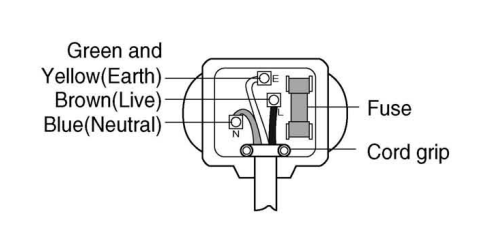
Important
Green and The wires in this mains lead are coloured in accordance with the following
- Green and yellow: Earth
- Blue(Neutral).
- Brown: Live
This appliance must be earthed.
As the colours of the wires in the mains lead of this apparatus may not correspond with the coloured markings identifying the terminals in your plug, proceed as follows:
The wire which is coloured Green and Yellow must be connected to the terminal in the plug which is marked with the letter E or by the earth symbol  or coloured Green or Green and Yellow. The wire which is coloured Blue must be connected to the terminal which is marked with the letter N or coloured Black.
or coloured Green or Green and Yellow. The wire which is coloured Blue must be connected to the terminal which is marked with the letter N or coloured Black.
The wire which is coloured Brown must be connected to the terminal which is marked with the letter L or coloured Red. Ifa 13 amp (BS 1363) plug is used, fit a 13 amp BS 1362 fuse.
Connecting water supply hose
- Water supply pressure must be between 100 kPa and 1000 kPa (1.0 - 10.0 kgf / cm’).
- Do not strip or crossthread when connecting inlet hose to the valve.
- If the water supply pressure is more than 1000 kPa, a decompression device should be installed
- Periodically check the condition of the hose and replace the hose if necessary.
Step1 : Check rubber seal inlet hose

Two rubber seals are supplied with the water inlet hoses.
They are used for preventing water leaks. Make sure the connection to taps is sufficiently tight.
Step2 : Connect hose to water tap
Type-A : Connecting Screw-type hose to tap with thread
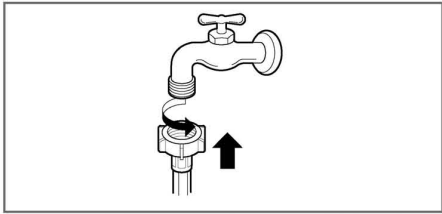
Screw the hose connector onto water supply tap.
Type-B : Connecting Screw-type hose to tap without thread
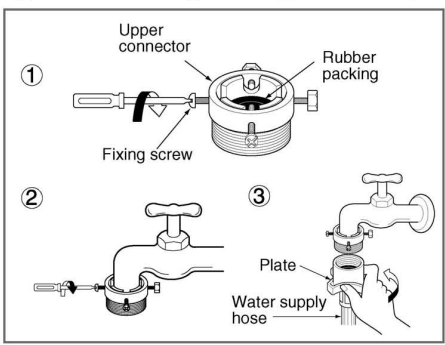
- Unscrew the adapter ring plate and the 4 adapter retaining screws.
- Push the adapter onto the end of the tap so that the rubber seal forms a watertight connection. Tighten the adapter ring plate and the 4 screws.
- Push the water supply hose vertically upwards so that the rubber packing within the hose can adhere completely to the tap and then tighten it by screwing it to the right.
Type-C : Connecting one touch type hose to tap without thread
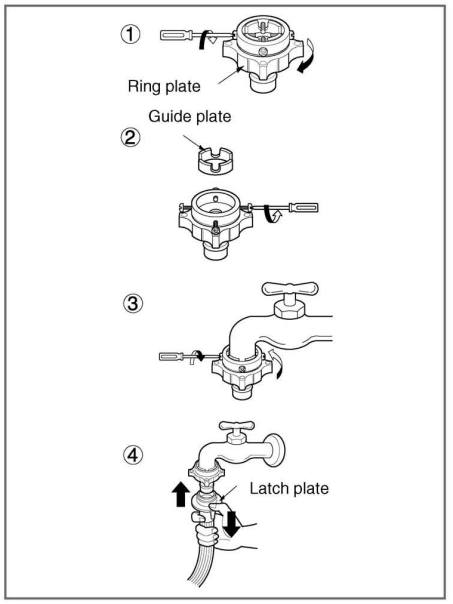
- Unscrew the adapter ring plate and the 4 adapter retaining screws.
- Remove the guide plate if the tap is too large to fit the adapter.
- Push the adapter onto the end of the tap so that the rubber seal forms a watertight connection.
- Tighten the adapter ring plate and the 4 screws.
- Pull the connector latch plate down. push the inlet hose onto the adapter. and release the connector latch plate. Make sure the adapter locks into place.
Note: After connecting inlet hose to water tap. turn on the water tap to flush out foreign substances (dirt. sand or sawdust) in the water lines. Let water drain into a bucket. and check the water temperature.
Step3: Connect hose to washer

- Make sure that there are no kinks in the hose and that they are not crushed.
*When your washer has two valves:
- The Inlet hose which has red connector is for the hot water tap.
- If the washer has two valves. the energy is saved by using hot valve.
Note: After completing connection. if water leaks from the hose, repeat the same steps. Use the most conventional type of faucet for water supply. In case the faucet is square or too big, remove the spacing ring before inserting the faucet into the adaptor.

Installation of drain hose

The drain hose should not be placed higher than 100 cm above the floor. Water in the washer does not drain or drains slowly.
- Securing the drain hose correctly will protect the floor from damage due to water leakage.
- If the drain hose is too long. do not force back into the washer. This will cause abnormal noise.
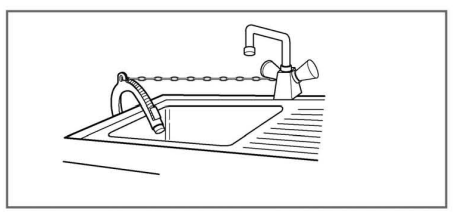
- When installing the drain hose to a sink. secure it tightly with string.
- Securing the drain hose correctly will protect the floor from damage due to water leakage.
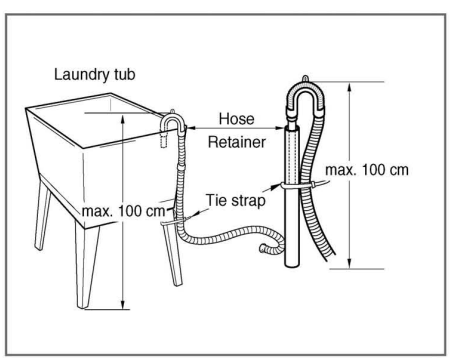
Leveling
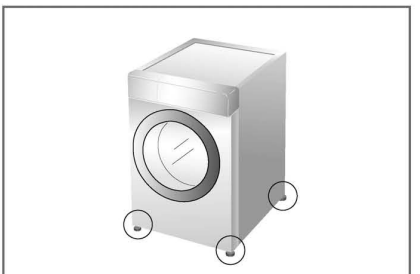
1. Leveling the washing machine properly prevents excessive noise and vibration. Install the appliance on a solid and level floor surface. preferably in a corner of the room.
Note: Timber or suspended type flooring may contribute to excessive vibration and unbalance.
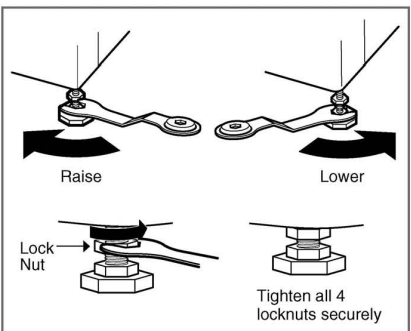
2. If the floor is uneven, turn the adjustable feet as required. (do not insert pieces of wood etc, under the feet) Make sure that all four feet are stable and resting on the floor and then check that the appliance is perfectly level. (Use a spirit level)
- Once the washer is level, tighten the lock nuts up towards the base of the washer. All lock nuts must be tightened.
- Diagonal Check
- When pushing down the edges of the washing machine top plate diagonally. the machine should not move up and down at all (Please, check both directions). If machine rocks when pushing the machine top plate diagonally, adjust the feet again.
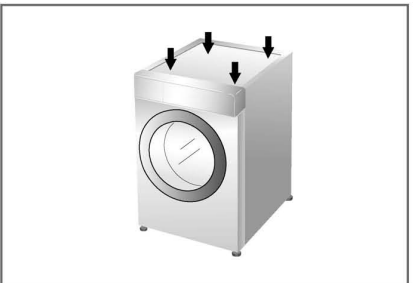
Note: If the washing machine is installed on a raised platform. it must be securely fastened in order to eliminate the risk of falling off.
Concrete floors
- The installation surface must be clean. dry and level.
- Install washer on a flat hard floor.
Tile floors (Slippery floors)
- Position each foot on the Tread Mate and level the machine to suit. (Cut Tread Mate into 70x70 mm sections and stick the pieces on to the dry tile where machine is to be placed.)
- Tread Mate is a self adhesive material used on ladders & steps that prevents slipping.
Wooden floors (Suspended floors)
- Wooden floors are particularly susceptible to vibration.
- To prevent vibration we recommend you place rubber cups under each foot under washer at least 15mm thick, secured to at least 2 floor beams with screws.
- If possible install the washer in one of the corners of the room. where the floor is more stable.
- Fit the rubber cups to reduce vibration.
- You can obtain the rubber cups (p/no.4620ER4002B) from the LG spares dept.

Note
- Proper placement and leveling of the washer will ensure long. regular and reliable operation.
- The washer must be 100% horizontal and stand firmly in position.
- It must not “Seesaw” across corners under load.
- The installation surface must be clean. free from floor wax and other lubricant coatings.
- Do not let the feet of the washer get wet. If feet of the washer get wet. slipping may occur.
How to use washer
Operating washing machine
1. Sort Laundry. (Refer to 18 page)
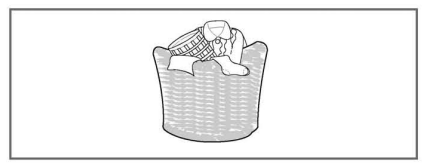
2. Open the door and load laundry.
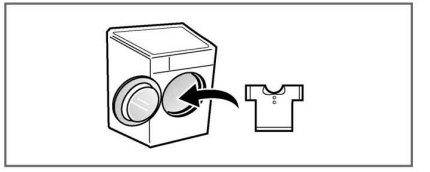
3. Touch the Power button.

4. Select a Program. (Refer to 19 ~ 21 page)
Select options at this time (Refer to 23 ~ 26 page)
- Options
- Temperature
- Spin Speed
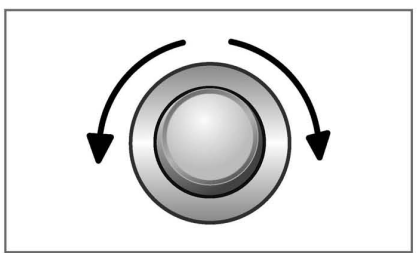
5. Add detergent. (Refer to 29 ~ 30 page)

6. Touch the Start/Pause button.

Care before washing
1. Care Labels
Look for a care label on your clothes. This will tell you about the fabric content of your garment and how it should be washed.
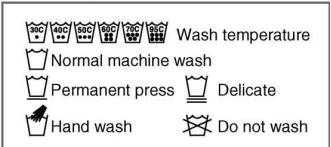
2. Sorting
To get the best results. sort clothes into loads that can be washed with the same wash cycle. Water temperature and spin speed and different fabrics need to be washed in different ways.
Always sort dark colors from pale colors and whites. Wash separately as dye and lint transfer can occur causing discolouration of white etc. If possible, do not wash heavily soiled items with lightly soiled one.
- Soil (Heavy, Normal, Light)
- Separate clothes according to amount of soil.
- Color (White. Lights. Darks)
- Separate white fabrics from colored fabrics.
- Lint (Lint producers. Collectors)
- Wash lint producers and lint collectors separately.
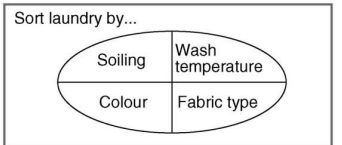
3. Caring before loading
Combine large and small items in a load. Load large items first. Large items should not be more than half the total wash load. Do not wash single items.
This may cause an out-of-balance load. Add one or two similar items.
- Check all pockets to make sure that they are empty. Items such as nails. hair clip. matches. pens, coins and keys can damage both your washer and your clothes.
- Close zippers hooks and strings to make sure that these items don't snag on other clothes.
- Pre treat dirt and stains by brushing a little detergent dissolved in water onto stains like collars and cuffs to help lift dirt.
- Check the folds of the flexible gasket (gray) and remove any small articles.
- Check inside of the drum and remove any item from a previous wash.
- Remove any clothing or items from the flexible gasket to prevent clothing and gasket damage.
Note: Before the first wash. select a cycle (Cotton 60°C, add a half load of detergent) allow the unit to wash without clothing. This will remove residues and water from the drum that may have been left during manufacturing.
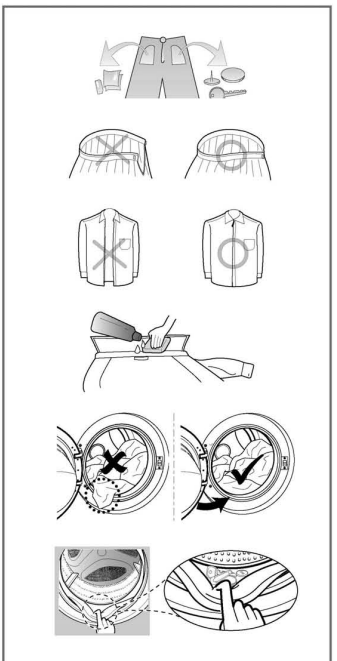
Washing program table
Recommended cycle according to the laundry type.

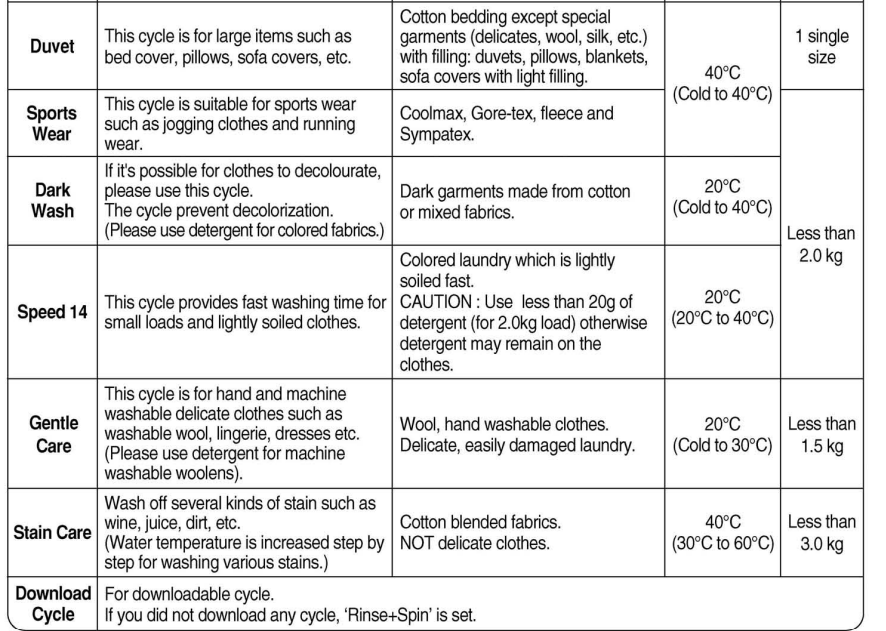
- Water Temperature: Select water temperature to suit wash cycles.
- Always follow garment manufacture’s care label or instructions when washing.
- Set program at "Cotton Large 40°C (Half Load)", "Cotton Large 60°C (Half Load)", "Cotton Large 60°C (Full Load)" option for test in conformity with EN60456 and Regulation 1015/2010.

- (They are suitable to clean normally soiled cotton laundry.)
- (They are the most efficient programmes in terms of combined energy and water consumptions for washing that type of cotton laundry.)
* Actual water temperature may differ from the declared cycle temperature.
- The test results depend on water pressure. water hardness. water inlet temperature, room temperature, type and amount of load, degree of soiling utilized detergent, fluctuations in the main electricity supply and chosen additional options.
NOTE: Neutral detergent is recommended.
Extra options
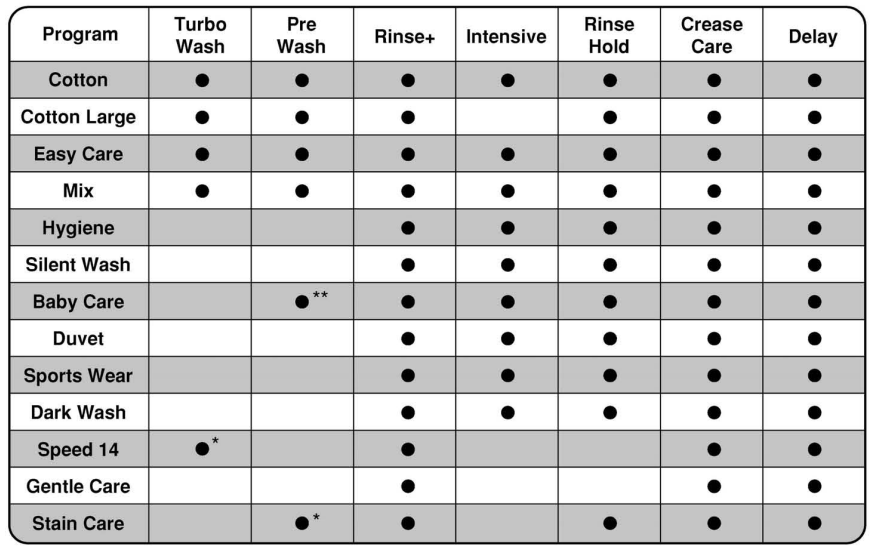
- This option is automatically included in the cycle and can not be deleted.
- This option is automatically included in the cycle and can be deleted.
Operating data
Program & Max RPM
- Cotton: 1400
- Cotton Large: 1400
- Easy Care: 1000
- Mix: 1400
- Hygiene: 1400
- Silent Wash: 1000
- Baby Care: 1000
- Duvet: 1000
- Sports Wear: 800
- Dark Wash:1400
- Speed 14: 800
- Gentle Care: 800
- Stain Care:1400
NOTE: Information of main washing programmes at half load.

Control panel
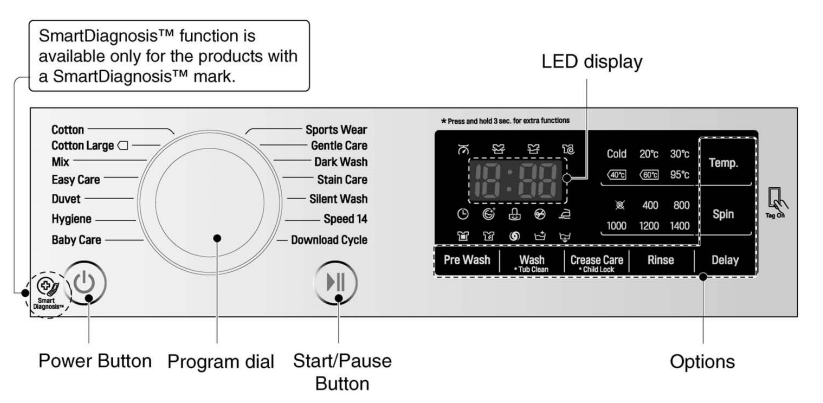
Power
- Press the Power button to turn power on and off.
- To cancel the Time Delay function. the power button should be pressed.
Start/Pause
- This Start/Pause button is used to start wash cycle or pause the wash cycle.
- If temporary stop of wash cycle is needed. touch the Start/Pause button.
- When in Pause. the power is turned off automatically after 4 minutes.
Program button
- Programs are available according to the laundry type.
- Lamp will light up to indicate selected program.
LED display
- The display shows the settings. estimated time remaining. options. and status messages for your washer.
- The display will remain on through the cycle.
Options
- This allows you to select an additional cycle and will light when selected.
- Use these buttons to select the desired cycle options for the selected cycle.
Options
Pre Wash (far) 
If the laundry is heavily soiled. “Pre Wash” cycle is effective.
- Press the Power button.
- Select a cycle.
- Touch the Pre Wash button.
- Press the Start/Pause button.
Delay 
You can set a time delay so that the washing machine will start automatically and finish after a specified time interval.
Note:
- The delay time is the time to the end of the programme. not the start.
- The actual running time may vary due to water temperature. wash load and other factors.
- Press the Power button.
- Select a cycle.
- Touch the Time Delay button and set time required.
- Press the Start/Pause button.
Crease Care 
If you want to prevent creasing select Crease Care option.
- Press the Power button.
- Select a cycle.
- Touch the Crease Care button.
- Press the Start/Pause button.
Wash 
- Turbo Wash
 : Wash cycle in under 1 hour with energy and water saving. (based on half of laundry)
: Wash cycle in under 1 hour with energy and water saving. (based on half of laundry) - Intensive
 : If the laundry is normal and heavily soiled. “Intensive” option is effective.
: If the laundry is normal and heavily soiled. “Intensive” option is effective.
Temp
- By touching the Temp, button the water temperature can be selected.
- Cold
- 20°C. 30°C. 40°C. 60°C. 95°C
- Water temperature can be selected according to the program.
Spin
- Spin Speed level can be selected by touching Spin’ button repeatedly.
- Spin Only
- Press the Power button.
- Touch the Spin button to select RPM.
- Press the Start/Pause.
Note: When you select "No Spin". it will still rotate for a short time with low speed to drain quickly.
Rinse 
- Rinse plus
 : Add rinse once.
: Add rinse once. - Rinse Hold
 : The cycle is paused until start button is touched again when rinse is finished.
: The cycle is paused until start button is touched again when rinse is finished.
Child Lock
Select this function to lock the buttons on the control assembly to prevent tampering.
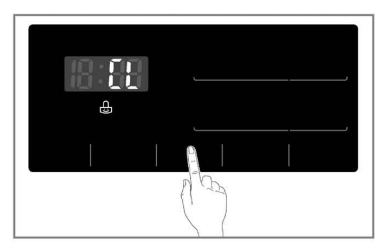
Locking the control panel
- Touch and hold the Child Lock button for 3 seconds.
- A beeper will sound. and
 will appear on the LED display. When the child lock is set. all buttons are locked except the Power button.
will appear on the LED display. When the child lock is set. all buttons are locked except the Power button.
Note Turning off the power will not reset the child lock function. You must deactivate child lock before you can access any other functions.
Unlocking the control panel
- Touch and hold the Child Lock button for 3 seconds.
- A beeper will sound and the remaining time for the current programme will reappear on the LED display.
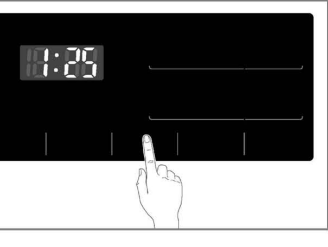
Beep On/Off
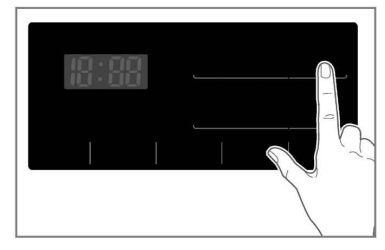
- Touch the Power button.
- Touch the Start/Pause button.
- Touch and hold the Temp. and Rinse button simultaneously for three seconds to set Beep on/off function. Once the Beep on/off function is set. the setting is memorized even after the power is turned off.
Note: If you want to turn the Beeper off. simply repeat this process.
Tub Clean 
Tub Clean is a special cycle to clean the inside of the washing machine.
A higher water level is used in this cycle at higher spin speed. Perform this cycle regularly.
- Remove any clothing or items from the washer and close the door.
- Open the dispenser drawer and add Anti limescale(e.g. Calgon) to the main wash compartment.
- Close the dispenser drawer slowly.
- Power On and then touch and hold Tub
- Clean button for 3 seconds. Then Ec’ and tub clean pictogram will be displayed on the LED display.
- Touch the Start/Pause button to start.
- After the cycle is complete. leave the door open to allow the washer door opening, flexible gasket and door glass to dry.
NOTE:
- Do not add any detergent to the detergent compartments.
- Excessive suds may generate and leak from the washer.
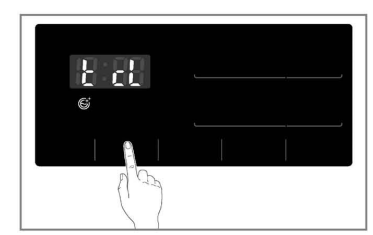
CAUTION: If there is a child. be careful not to leave the door open for too long.
Door Lock & Detecting
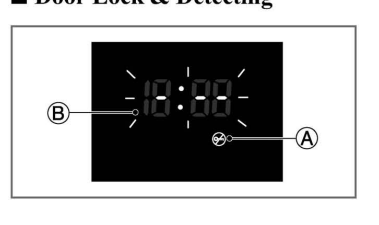
- A - “Door Lock” - For safety reasons, the door will lock while machine is in use and the “Door Lock” icon will light up.
- You can safely open the door after the “Door
- "Lock” icon turns off.
- B - While "Detecting" is shown on the display the washing machine rotates slowly and detects how much laundry is loaded in the drum.
- It will take a short time.
- The Tag On function allows you to conveniently use the LG SmartDiagnosis and Cycle Download features to communicate with your appliance right from your own smart phone.
- To use the Tag On function:
- Download the LG Smart Laundry & DW App to your smart phone.
- Turn on the NFC (Near Field Communication) function in your smart phone.
- The Tag On function can only be used with most smart phones equipped with the NFC function and based on the Android operating system (OS).
Turning on the NFC function of the smart phone
- Enter the "Settings" menu of the smart phone and select "Share & Connect" under "WIRELESS & NETWORKS".
- Set "NFC" and "Direct Android Beam" to ON and select "NFC".
- Check “Use Read and Write/P2P receive".
-
Note
- Depending on the smart phone manufacturer and Android OS version, the NFC activation process may differ.
- Refer to the manual of your smart phone for details.
The Tag On guide
Tag On position
-
 Tag On:
Tag On:
- Look for the Tag On icon next to the LCD screen on the control panel.
- This is where you position your smart phone when using the Tag On function with the LG SmartDiagnosisTM and Cycle Download features of the LG Smart Laundry & DW App.

- When you use the Tag On function. position your smart phone so that the NFC antenna on the back of your smart phone matches the position of the Tag On icon on the appliance.
- If you do not know the position of your NFC antenna. move your smart phone very slightly in a circular motion until the application verifies the connection.

- Because of the characteristics of NFC, if the transmission distance is too far. or if there is a metal sticker or a thick case on the phone. transmission will not be good. In some cases, NFC-equipped phones may be unable to transmit successfully.
- Press
 in the LG Smart Laundry & DW app for a more detailed guide on how to use the Tag On function.
in the LG Smart Laundry & DW app for a more detailed guide on how to use the Tag On function.
REGULATION
EU Conformity Notice:

LG Electronics hereby declares that this product is in compliance with the following Directives.
R&TTE Directive 1999/5/EC
ADDING DETERGENT
Adding detergent and fabric softener
The dispenser drawer

- Main wash only =>

- Pre Wash + Main Wash =>

WARNING
- Keep all washing detergents away from children as there is danger of poisoning.
- Too much detergent. bleach or softener may cause an overflow.
- Be sure to use the appropriate amount of detergent.
Adding fabric softener
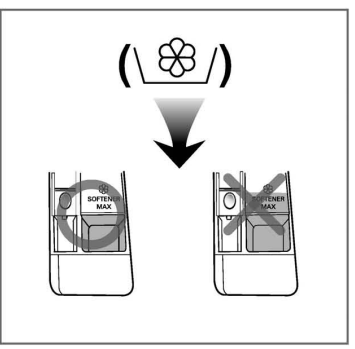
- Do not exceed the maximum fill line. Overfilling can cause early dispensing of the fabric softener which could stain clothes. Close the dispenser drawer slowly.
- Do not leave the fabric softener in the detergent drawer for more than 2 days, (Fabric softener could be harden)
- Softener will automatically be added during the last rinse cycle.
- Do not open the drawer when water is supplied.
- Solvents(benzene. etc) should not be used.
Note: Do not pour fabric softener directly on the clothes.
Detergent dosage
- Detergent should be used according to the instruction of the detergent manufacturer and selected according to type. colour. soiling of the fabric and washing temperature.
- If too much detergent is used. too many suds can occur and this will decrease the washing result or cause heavy load to the motor.
- It is recommended that you use powdered detergent for best results.
- If you wish to use liquid detergent follow guidelines provided by the detergent manufacturer.
- You can pour liquid detergent directly into the main detergent drawer if you are starting the cycle immediately.
- Please do not use liquid detergent if you are using Time Delay’ as the liquid may harden. or if you have selected Pre Wash’.
- If too many suds occur. please reduce the detergent amount.
- Detergent usage may need to be adjusted for water temperature. water hardness. size and soil level of the load. For best results. avoid oversudsing.
- Refer to the label of the clothes. before choose the detergent and water temperature.
- To use the washing machine. put the designated detergent only.
- General powdered detergents for all types of fabric (Cold - 95°C)
- Powdered detergents for delicate fabric (Cold - 40°C)
- Liquid detergents for all types of fabric (Cold - 95°C) or designated detergents only for wool (Cold - 40°C)
- For better washing performance and whitening. use the detergent with the General powdered bleach.
WARNING
- Do not let the detergent harden.
- Doing so may lead to blockages. poor rinse performance or bad odor.
Note
- Full load : according to manufacturer's recommendation.
- Part load : 3/4 of the normal amount.
- Minimum load : 1/2 of full load.
Detergent is flushed from the dispenser at the beginning of the cycle.
Adding water softener
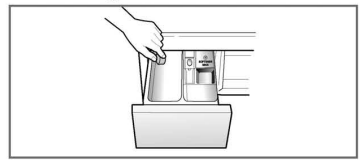
- A water softener, such as Anti-limescale (e.g. Calgon) can be used to cut down on the use of detergent in extremely hard water areas.
- Dispense according to the amount specified on the packaging. First add detergent and then the water softener.
- Use the quantity of detergent as for soft water.
Using tablet
1. Open the door and put tablets into the drum.
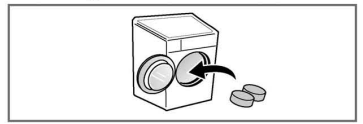
2. Load the laundry into the drum and close the door.
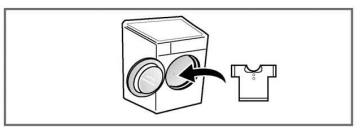
Maintenance
- Before cleaning the washer interior. unplug the electrical power cord to avoid electrical shock hazards.
- Turn off the stopcock if the machine is to be left for any length of time (e.g. holiday), especially if there is no floor drain(gully) in the immediate vicinity.
The water inlet filter
- "
 “ icon will be displayed on the control panel when water does not enter the detergent drawer.
“ icon will be displayed on the control panel when water does not enter the detergent drawer. - If water is very hard or contains traces of lime deposit. the water inlet filter may become clogged.
- It is therefore a good idea to clean it from time to time.
- Turn off the water tap.
- Unscrew the water inlet hose.
- Clean the filter using a hard bristle brush.
- Tighten up the inlet hose.
The drain pump filter
- The drain filter collects threads and small objects left in the laundry.
- Check regularly that the filter is clean to ensure smooth running of your machine.
CAUTION: First drain using the drain hose and then open the pump filter to remove any threads or objects. Be careful when draining if the water is hot.
Allow the water to cool down before cleaning the drain pump. carrying out emergency emptying or opening the door in an emergency.
- Open the lower cover cap. pull out the hose.
- Unplug the drain plug.
- Open the filter by turning to the left.
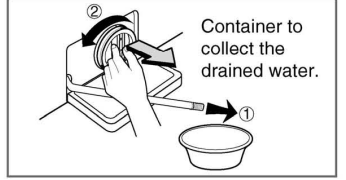
- Remove any extraneous matter from the pump filter.
- After cleaning. turn the pump filter and insert the drain plug.
- Close the lower cover cap.
Dispenser drawer
- After a while. detergents and fabric softeners leave a deposit in the drawer.
- It should be cleaned from time to time with a jet of running water.
- If necessary it can be removed completely from the machine by pressing the catch downwards and by pulling it out.
- To facilitate cleaning, the upper part of the fabric softener compartment can be removed.
- Pull out the dispenser drawer.
- Clean the dispenser drawer under water.
- Clean inside the recess with an brush.
- Insert the dispenser drawer.
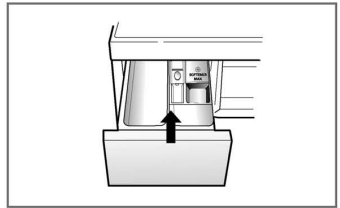
The washing drum
- If you live in a hard water area. limescale may build up continuously in places where it cannot be seen and thus not easily removed. Over time the build up of scale clogs appliances. and if it is not kept in check these may have to be replaced.
- Although the washing drum is made of Stainless steel. specks of rust can be caused by small metal articles (paper clips, safety pins) which have been left in the drum.
- The washing drum should be cleaned from time to time.
- If you use descaling agents. dyes or bleaches. make sure they are suitable for washing machine use.
- Descaler may contain chemicals that may damage part of your washing machine.
- Remove any spots with a stainless steel cleaning agent.
- Never use steel wool.
Cleaning your washer
Exterior
- Proper care of your washer can extend its life.
- The outside of the machine can be cleaned with warm water and a neutral non abrasive household letergent.
- Immediately wipe off any spills. Wipe with damp cloth.
- Try not to hit surface with sharp objects.
- Do not use methylated spirits. diluents or similar products.
Interior
- Dry around the washer door opening. flexible gasket and door glass.
- Run washer through a complete cycle using hot water.
- Repeat process if necessary.
- Dilute 5g of bleach with 5¢ of warm water. (1000 times dilution)
- Wipe the gasket by using diluted bleach. (MUST wear the rubber gloves)
- Dry up the gasket by using a dry cloth.
- Open the door until it is completely dry.
- Clean the gasket more than once a month.
- use of undiluted bleach may damage parts of the washing machine.
Note: To remove hard water deposits. use only cleaners labelled washer safe.
Cold conditions
- If the washer is stored in an area where freezing may occur or moved in freezing temperatures. follow these instructions to prevent damage to the washer:
- Tum off water supply tap.
- Disconnect hoses from water supply and drain water from hoses.
- Plug electrical cord into a properly grounded electrical outlet. a gallon (3.8L) of nontoxic recreational vehicle(RV) antifreeze into an empty wash drum. Close the 10 or.
- Set re cycle and let washer spin for 1minute to drain out all water. Not all of the RV antifreeze will be expelled.
- Unplug electrical power cord. dry the drum interior. and close the door.
- Remove dispenser drawer. drain and dry excess water from the compartments.
- Store washer in an upright position.
- To remove antifreeze from washer after storage. run empty washer through a complete cycle using detergent. Do not add wash load.
Troubleshooting guide
This washing machine is equipped with automatic safety functions which detect and diagnose faults at an early stage and react appropriately.
When the machine does not function properly or does not function at all. check the following points before you contact your service provider.
Diagnosing Problem
Symptom, Possible & Cause Solution
- Rattling and clanking noise
- Foreign objects such as coins or safety pins maybe in drum or pump.
- Stop washer, check drum and drain filter.
- If noise continues after washer is restarted, call your authorised service centre.
- Foreign objects such as coins or safety pins maybe in drum or pump.
- Thumping sound
- Heavy wash loads may produce a thumping sound. This is usually normal.
- If sound continues, washer is probably out of balance. Stop and redistribute wash load.
- Heavy wash loads may produce a thumping sound. This is usually normal.
- Vibrating noise
- Have all the transit bolts and packing been removed?
- Are all the feet resting firmly on the ground?
- If not removed during installation. refer to Installation guide for removing transit bolts.
- Wash load may be unevenly distributed in drum. Stop washer and rearrange wash load.
-
Water leaks.
-
Fill hoses or drain hose are loose at tap or washer.
-
Check and tighten hose connections.
-
-
House drain pipes are clogged.
-
Unclog drain pipe, Contact plumber if necessary.
-
-
-
Oversudsing
-
Too much detergent or unsuitable detergent may cause excessive foaming which may result in water leaks.
-
-
Water does not enter washer or it enters slowly
-
Water supply is not adequate in area.
-
Check another tap in the house.
-
-
Water supply tap is not completely open.
-
Fully open tap.
-
-
Water inlet hose(s) are kinked.
-
Straighten hose.
-
-
The filter of the inlet hose(s) clogged.
-
Check the filter of the inlet hose.
-
-
-
Water in the washer does not drain or drain slowly.
-
Drain hose is kinked or clogged.
-
Clean and straighten the drain hose.
-
-
The drain filter is clogged.
-
Clean the drain filter.
-
-
- Washer does not start.
- Electrical power cord may not be plugged in or connection may be loose.
- Make sure plug fits tightly in wall outlet.
- House fuse blown. circuit breaker tripped. or a power outage has occurred.
- Reset circuit breaker or replace fuse. Do not increase fuse capacity.
- If problem is a circuit overload. have it corrected by a qualified electrician.
- Water supply tap is not turned on.
- Turn on water supply tap.
- Electrical power cord may not be plugged in or connection may be loose.
- Washer will not spin.
- Check that the door is firmly shut.
- Close the door and touch the Start/Pause button. After touching the Start/Pause button. it may take a few moments before the washer begins to spin. The door must be locked before spin can be achieved. Add 1 or 2 similar items to help balance the load. Rearrange load to allow proper spinning.
- Check that the door is firmly shut.
- Door does not open.
- Once machine has started. the door cannot be opened for safety reasons. Check if the "Door Lock" icon is illuminated. You can safely open the door after the "Door Lock" icon turns off.
- Wash cycle time delayed
- The washing time may vary by the amount of laundry. water pressure. water temperature and other usage conditions. If an imbalance is detected or if the suds removing programme is on. the wash time shall be increased.
-
Fabric softener overflow
-
Too much softener may cause an overflow.
-
Follow softener guidelines to ensure appropriate amount is used. Do not exceed the maximum fill line
-
-
-
Softeners dispensed too early
-
Close the dispenser drawer slowly.
Do not open the drawer during the wash cycle.
-
Error Messages
1. 
- Water supply is not adequate in area.
- Check another tap in the house.
- Water supply taps are not completely open.
- Fully open tap.
- Water inlet hose(s) are kinked.
- Straighten hose(s).
- The filter of the inlet hose(s) are clogged.
- Check the filter of the inlet hose.
2. 
- Drain hose is kinked or clogged.
- Clean and straighten the drain hose.
- The drain filter is clogged.
- Clean the drain filter.
3. 
- Load is too small.
- Load is out of balance.
- The appliance has an imbalance detection and correction system. If individual heavy articles are loaded (e.g. bath mat. bath robe. etc.) this system may stop spinning or even interrupt the spin cycle altogether.
- If the laundry is still too wet at the end of the cycle. add smaller articles of laundry to balance the load and repeat the spin cycle.
- Add 1 or 2 similar items to help balance the load.
- Rearrange load to allow proper spinning.
4. 
- Ensure door is not open.
- Close the door completely.
- If
 is not released call for service.
is not released call for service.
5. 
- Unplug the power plug and call for service.
6. 
- Water overfills due to the faulty water valve.
7. 
- Water level sensor has malfunctioned.
- Close the water tap.
- Unplug the power plug.
- Call for service.
8. 
- Over load in motor.
- Allow the washer to stand for 30 minutes to allow the motor to cool; then restart the cycle.
NOTE: SmartDiagnosisTM function is available only for the products with a SmartDiagnosis mark. In case of a mobile phone with static option. the SmartDiagnosis function might not operate.
Using SmartDiagnosisTM
- Only use this feature when instructed to do so by the call center. The transmission sounds similar to a fax machine. and so has no meaning except to the call center.
- SmartDiagnosis cannot be activated if the washer does not power up. If this happens. then troubleshooting must be done without SmartDiagnosis.
If you experience problems with your washer. call to Customer Information Center. Follow the calll center agent's instructions. and do the following steps when requested:

- Press the Power button to turn on the washer. Do not press any other buttons or turn the cycle selector knob.
- When instructed to do so by the call center. place the mouthpiece of your phone very close to the Power button.
- Touch and hold the “Temp.” button for three seconds. while holding the phone mouthpiece to the icon or Power button.
- Keep the phone in place until the tone transmission has finished. This takes about 6 seconds. and the display will count down the time.
- For best results. do not move the phone while the tones are being transmitted.
- If the call center agent is not able to get an accurate recording of the data. you may be asked to try again.
- Once the countdown is over and the tones have stopped. resume your conversation with the call center agent. who will then be able to assist you using the information transmitted for analysis at the call to Customer information center.
- Smart Diagnosis is a troubleshooting feature designed to assist. not replace. the traditional method of troubleshooting through service calls. The effectiveness of this feature depends upon various factors. including. but not limited to. the reception of the cellular phone being used for transmission. any external noise that may be present during the transmission. and the acoustics of the room where the machine is located.
- Accordingly LG does not guarantee that Smart DiagnosisTM would accurately troubleshoot any given issue.
Operating data
